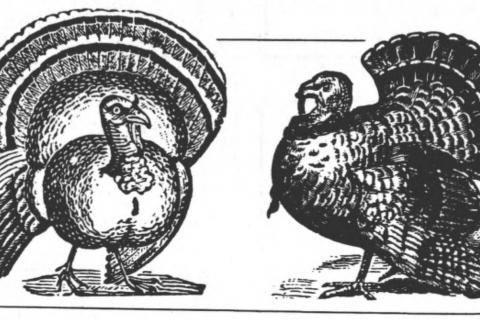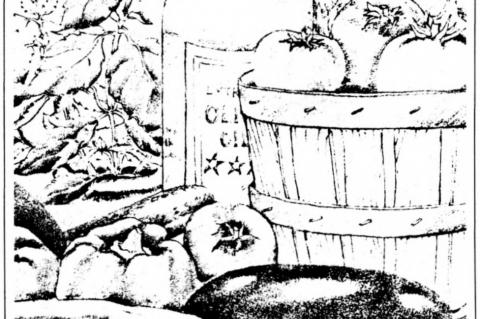“Man is an epicure just as he is an artist, a scholar, a poet. The palate . . . is as delicate and susceptible of training as the eye or ear, and equally deserving of respect.” — Guy de Maupassant, Madame Husson’s Rose-king
Recipes
 Long Island Larder: Creole Fish Gumbo
Long Island Larder: Creole Fish GumboThis spicy blend of fish, shrimp, and okra isn’t at all difficult to make, but the timing of each ingredient added must be adhered to precisely, because cooking times are brief and overcooking ruins the dish.
 The Long Island Larder: Winter Vegetable Stew
The Long Island Larder: Winter Vegetable Stew"Memory recalls dishes that have pleased the taste; imagination pretends to see them; there is something dreamlike about the whole process." — "On Appetite," Brillat-Savarin
Here we are — locked in the drears of January with nothing much active and pleasurable to do. Except cook! And think about food we shouldn't have and still stick to the traditional New Year's vow to lose 10 pounds.
 Long Island Larder: Sweet Tooth Sharpened
Long Island Larder: Sweet Tooth SharpenedThis fudge pie is a “gooey-on-the-inside, crunchy-on-the-outside, heavenly piece of chocolate wickedness,” and the lemon-curd tarts have a rich filling that can also be used in lemon meringue pie or a layer-cake filling.
 Pea Soup, Farmer's Style
Pea Soup, Farmer's StyleThis is one of the world's great peasant soups, the emblematic soup of Quebec, in fact. Despite this, with our normal maddening indifference to our 'friendly giant to the north,' Canada, there are no recipes to be found for this great soup in any American cookbook I've seen. I tracked it down through a friend in Montreal.
 Long Island Larder: Charcoal Turkey Tangerine
Long Island Larder: Charcoal Turkey TangerineThe bald eagle may be the emblem of the United States, but I think Benjamin Franklin got his wish even though it has not been proclaimed by any official source: Turkey is the national bird.
 Long Island Larder: Eggplants Stuffed With Rice
Long Island Larder: Eggplants Stuffed With Rice“Often called 'poor man's meat' and, in one form, 'poor man's caviar,' the eggplant is one of the staple foods of the Middle East. It is extremely versatile." — Claudia Roden, “A Book of Middle Eastern Food”
 Long Island Larder: Ways to Enjoy Corn
Long Island Larder: Ways to Enjoy CornCorn has ears and we’d all better sneak up on it as rapidly as possible.
 Long Island Larder: Precious Plums
Long Island Larder: Precious Plums“The varieties of plum are legion, and have been at least since Roman times when Pliny spoke of the ingens turba prunorum, the enormous crowd of plums.” — Jane Grigson’s "Fruit Book"
The great menagerie of plums begins now and goes on through August, with this luscious stone fruit ranging from blue-black, through the reds and rubies, and on to yellow and the pale, almost translucent green of greengages.
 Long Island Larder: Shrimp and Scallop Pasta
Long Island Larder: Shrimp and Scallop Pasta"Lake shrimp are always used in making this gumbo, the river shrimp being too small and delicate. Purchase three to four pounds, or about 100 shrimp, for there are always smaller shrimp in the pile which, when cooked, amount to little or nothing.”
- "The Picayune Creole Cookbook," 1901 edition
 The Long Island Larder: Spinach Is the Key Ingredient
The Long Island Larder: Spinach Is the Key IngredientI don’t think I’d ever had anything but canned spinach growing up, and it was pretty bad stuff. Nowadays, frozen spinach has taken over from the canned, and fresh leafy green spinach is still not an everyday commodity. The reason for this, besides perishability, is that not many people think that swishing spinach through three changes of water constitutes a fun time.
 Long Island Larder: Almost Time for Weakfish
Long Island Larder: Almost Time for WeakfishWeakfish, a.k.a. squeteague or sea trout, has begun its annual migration in large schools up the Atlantic coast. . . . The name, weakfish, is no slur on its character; it refers to the delicate mouth of this fish, which is easily torn by a hook. Otherwise the weak has a lean and flaky white flesh that is delicious when very freshly caught. It tends to become soft and flabby if not cooked right away and its blandness needs some exciting flavor accents to be interesting.
 Edible Delights: When Flowers Are Ingredients
Edible Delights: When Flowers Are IngredientsFlowers, with their sweet fragrances and riotous color, are balm for the senses and for the eye. Of late, nouvelle-trendy watering spots have introduced them as stylish garnish and amusing nibbles. Less known is the fact that flowers were a common and popular ingredient in recipes in the 17th, 18th, and 19th centuries.
 Long Island Larder: Ham for Easter
Long Island Larder: Ham for EasterHam is to Easter what turkey is to Thanksgiving and it’s best not to tamper too much with tradition. Of course, lamb is traditional if you happen to be Greek, but ham for Easter has come to be the unshakable custom in most American households.
 Long Island Larder: Christmas Feasting
Long Island Larder: Christmas FeastingThat comforting line about Christmas coming “but once a year” might ring hollow in your ears, with Christmas parties and Christmas drop-ins to be dealt with by the genial host. To be always at the ready, there are fortunately some delicious things that can be made in advance and refrigerated and served on several occasions.
 Recipe: Tarte Tatin
Recipe: Tarte TatinHere's a French version of apple pie alleged to have been invented by two spinsters who ran a rustic restaurant in Lamotte-Beauvron, a hamlet not far from Paris.
 Recipe: "Hermits," or Spice-Laden Cookies
Recipe: "Hermits," or Spice-Laden Cookies"Hermits" are chewy, spice-laden cookies that date back to early 19th-century cookery in America, and there are many variations on the basic recipe.
 Long Island Larder: Meat Loaf Revisited
Long Island Larder: Meat Loaf Revisited“Poets have been mysteriously silent on the subject of cheese." — G.K. Chesterton
Upon reading this, a poet friend of mine, William Cole, sat down and composed a nine-stanza ode to cheese called “What a Friend We Have in Cheeses!” subtitled “Sing a Song of Liederkranz.” But neither he nor anyone else seems to have gotten around to penning a single line to meat loaf, a subject that sends perfectly rational people into raptures.
 Long Island Larder: Pumpkins in Soup, Pumpkins in Bread
Long Island Larder: Pumpkins in Soup, Pumpkins in BreadMost of the pumpkins dotting the fields with the brilliant orange will get their 15 minutes of celebrity on Halloween night. For although this hardy member of the squash-gourd family grows ubiquitously both in this hemisphere and in Europe, there are few recipes for its use. Too bad, because the pumpkin’s hard rind keeps it usable for many months past the Thanksgiving pie season.
 Long Island Larder: Eggplant Two Ways
Long Island Larder: Eggplant Two WaysEggplant seems to be available the year around nowadays, but is more than usually plentiful during the last warm days of September.
 Long Island Larder: Party Food on a Budget
Long Island Larder: Party Food on a BudgetThere are lots of party foods that can be made in advance at no great expense. The money saved can be used to hire the bartenders and waiters that are essential if the hosts are to have any fun at all and remain on speaking terms with each other.
 Blueberry-Peach Shortcakes on Cornmeal Biscuits
Blueberry-Peach Shortcakes on Cornmeal BiscuitsFlorence Fabricant decided to take advantage of the lush peaches and excellent blueberries that will be at their zenith in flavor during late July. There are already fine peaches and berries in the market so you can make this right away.
 Marinated Shrimp With Lemons and Onions
Marinated Shrimp With Lemons and OnionsMary Emmerling has elected to serve a menu from her newly published book, “American Country Cooking.” This hors d’oeuvre will lead things off at her dress-in-white summer dinner for ten.
 Long Island Larder: Growing Herbs and Putting Them to Use
Long Island Larder: Growing Herbs and Putting Them to UseI don't know if herbs have ever before crossed national boundaries in such a massive immigration as they are invading American cookery of the ’80s. Dill used to be Scandinavian; oregano Italian, and the less common anise-flavored tarragon, strictly French. The English were sage; Mexican, coriander, and I don’t know what we were — parsley, maybe. Now they’ve come to an enthusiastic melting pot and American cookery really sings with all these different accents.
 Long Island Larder: Lamb With Peppercorns and Lamb Pastitcio
Long Island Larder: Lamb With Peppercorns and Lamb Pastitcio All this lamb talk is because we are smack-dab in the middle of “spring lamb season,” which is largely myth nowadays because lambs are born all year round in different parts of the country.
Except for Easter basket bunnies, white chocolate used to be relatively difficult to find, but the Nestle Company produces a “baking bar” carried in most supermarkets.
 Long Island Larder: Poulet a la Crème
Long Island Larder: Poulet a la Crème“True genius always looks simple, and the best of creations are 'obvious.'" — Rudolph Chelminski, “The French at Table.”
 Long Island Larder: A Few Reminders of Summer
Long Island Larder: A Few Reminders of SummerAlthough it’s always been my credo to try to live by the seasons in the Long Island Larder, there are times when the seasons need a little forcing — like dreary February.
 Long Island Larder: Souffles Free-Style, 1988
Long Island Larder: Souffles Free-Style, 1988Souffles have magic and mystery — they’re always box office even though their simple trickery has long been familiar. This is great for the January blahs when we all need some different, innovative, out-of-the-rut food.
 January Blues Stew, 1988
January Blues Stew, 1988This is a thick version of summer’s soupe au pistou, changed to make use of vegetables available locally in winter. Fresh basil grows in my greenhouse, but as it isn’t usually buyable in winter, use bottled pesto sauce, which can be bought in specialty food shops to provide the finishing earthy flavor of this soul and belly-warming stew.
Pagination
Copyright © 1996-2024 The East Hampton Star. All rights reserved.



